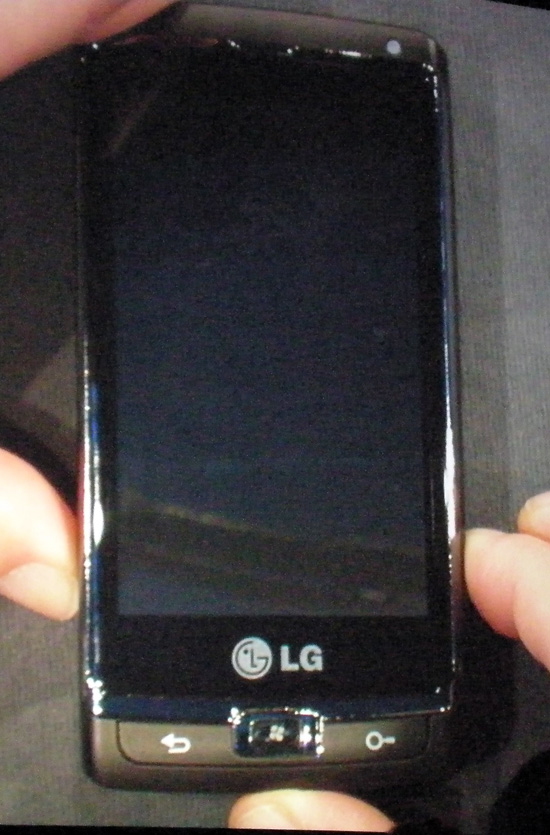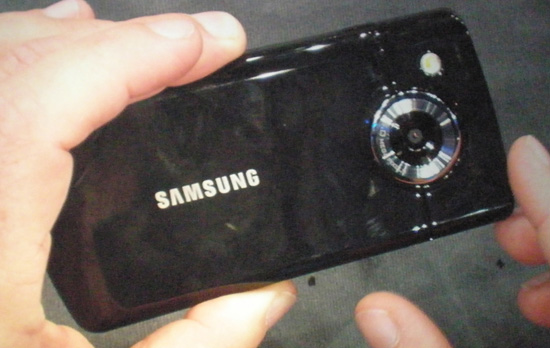Windows Phone 7 Series at MIX10
by Brian Klug on March 16, 2010 12:00 AM EST- Posted in
- Smartphones
- Mobile
Three Handsets
Thus far, we've seen three handsets from different hardware partners.
The most common of which is the ASUS-built but completely unbranded handset Microsoft is using for most if not all of its demos and hands-ons. I understand this is what Microsoft is distributing to its team internally for development and day to day dogfooding. We've seen this device before numerous times.
There are also now two new devices: First, an LG device with full slide out keyboard. Unfortunately, its battery was dead on-stage and we haven't seen it turned on. This device was first shown during the Engadget show some time ago.

Next is a Samsung handset with no slide out keyboard and a large rear camera.


Nothing further has been said about either of these two new hardware designs, but there are definitely more coming. Curiously absent is Microsoft's traditional major Windows Mobile partner, HTC. We can only assume much more hardware is eventually coming down the pipes.
Demonstration Software
Microsoft emphasized the differences between the Silverlight and XNA framework applications are largely transparent to the user, and showed this off using a number of relatively impressive programs. AP's Mobile News reader, Jackson Fishmarket's Hush Hush Diary, Colorizer, Seesmic, and Graphic.LY were amongst the selected demo applications, with references to many more existing in contextual menus within hubs.
But perhaps the most intriguing and potentially killer application for the handset was Netflix. Since Netflix already heavily relies on Silverlight for streaming media delivery, it's an ideal showcase for Phone 7 Series. Instant playback worked flawlessly. If carriers don't explode at the notion of users streaming the Netflix catalog over already close-to-saturation 3G networks, this alone could be a potentially killer application.
Final Words
Microsoft has answered many of the questions lingering after Windows Phone 7 Series' announcement at Mobile World Congress, however much more remains to be covered at MIX10. Stay tuned!










24 Comments
View All Comments
nerdtalker - Tuesday, March 16, 2010 - link
I'm still doing digging on the subject, but I asked some of the XNA reps/devs about that out of curiosity.They mentioned that on virtually all the ARM SoC the choice of OpenGL versus Direct X is entirely just a matter of drivers. In fact, they reiterated a few times that they consider the OpenGL implementation a bit "academic" and slower than the Direct3D/DirectX APIs they have written.
I was puzzled about that too since most of the SoC is advertised as having some level of OpenGL compatibility. There's also some confusion about what shader model is supported; I'm told in the current release there aren't any programmable shaders, but that's not to say it can't happen.
PsychoPif - Wednesday, March 17, 2010 - link
There is no shader support at release, but it's expected later down the pipe.At launch, they added configurable shade effect to the basic ones. reports said that it was a good enough to make nice looking scenes, but don't quote me on that :)
deputc26 - Tuesday, March 16, 2010 - link
Really looking forward to some Anand-quality coverage of Android. I'm rather surprised that the yet-unlaunched Winmo7 and the floundering (though exceptional) WebOs have gotten Anand's and yet Android has not.Anand Lal Shimpi - Tuesday, March 16, 2010 - link
It's coming... :)Take care,
Anand